 |
 |
 |
 |
 |
Ni-Ti
alloys with pseudo-elasticity /
shape-memory for medical applications
|
 |
 |
 |
Ni-Ti
alloys are a class of alloys that feature some very special (and in
their combination absolutely unique) properties, particularly shape
memory, pseudo-elasticity and biocompatibility. For several decades,
their usage in technical applications has been rather limited though,
until their applicability for medical implants was discovered and more
and more exploited. Minimal invasive surgery techniques have been
completely redesigned and drastically enhanced by using shape memory or
pseudo-elasticity and an adequate construction. Implants made of Ni-Ti
can be folded and positioned at their location in the human body
through a catheter. Upon leaving the catheter they unfold, resume their
original shape and fulfill their function, e.g. support blood vessels
(stents) or close holes in the body tissue (occlusion devices).
|
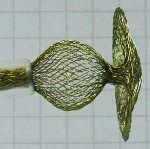
|
|
 |
 |
|
|
 |
 |
Oxidation
mechanism of Ni-Ti
|
 |
 |
 |
One
of the hazards of Ni-Ti alloys is the potential Ni release during its
application. In contact with human tissue the Ni release may cause
allergic reactions or inflammatory response. However, a well designed
surface layer of almost Ni-free Titanium oxide can prevent the Ni
release effectively. The oxide layer also passivates the material with
respect to corrosion. It can be generated by a tailored heat treatment
under air atmosphere, or by electrochemical processes. The type and
amount of defects in the oxide layer strongly influence its behavior.
The most crucial parameter is the oxide layer thickness. It can even be
judged (qualitatively) by the color of the material, as the oxide layer
thickness is subject to interference phenomena with visible light. To
generate almost Ni-free surface oxide layers that prevent Ni-release,
understanding the oxidation mechanism of Ni-Ti plays a key role. The
diffusion processes during oxidation are investigated in marker
experiments using different stable isotopes of the constituent elements
and resonant Rutherford Backscattering Spectroscopy (RRBS).
|
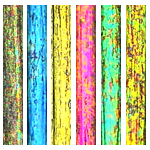
|
|
 |
 |
|
|
 |
 |
Mechanical
stability of oxide layers on Ni-Ti during pseudo-elastic deformation
|
 |
 |
 |
When
during oxidation an essentially Ni-free surface oxide layer is formed,
mass conservation requires that underneath there is a layer that is
enriched in Ni. The mechanical stability of the oxide layer upon
pseudo-elastic deformation is critical inasmuch as damage to the oxide
layer will set the Ni-rich layer free, and the effective protection
against Ni-release from the alloys will deteriorate. The formation of
macroscopic defects is investigated by in-situ straining experiments in
the SEM. Depending on the thickness of the surface oxide layers
different kinds of disruptions are observed. If the thickness of the
oxide layer exceeds values of 80nm, the overlay of longitudinal
deformation and transversal contraction will result in partial flaking
of the oxide layer. Thus controlling the thickness is a fundamental
aspect concerning the mechanical stability of the oxide layers.
|

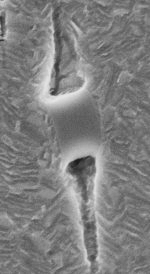
|
|
 |
 |
|
|
 |
 |
Structural
properties of Ni-Ti for medical application
|
 |
 |
 |
To
achieve the best possible results in surgery with NiTi Implants,
reproducible adjustment of the structural properties such as strength
or pseudo-elastic deformation, is necessary.
Pseudo-elasticity and shape memory effect are governed by the
martensite-austenite transformation of the NiTi phase. In the present
project the options of controlling the transformation temperature and
the transformation characteristics by short time annealing are
investigated. Depending on duration and temperature of the annealing,
substantial alteration of transformation temperatures and
transformation characteristics occur. Detailed investigations are
carried out to characterize the complex interactions of recovery,
recrystallization and the formation of Ni-rich precipitates. One of the
basic results is that the material’s properties are extremely
sensitive to slight changes in the annealing parameters – for
medical purposes a precise control of the annealing parameters is
indispensable.
|
|
|
 |
 |
|
|
|
 |
Characterization
of the fatigue behavior of occlusion implants
|
 |
|
 |
A
fatigue testing device has been developed that mimics loading and
deformation of occlusion implants in the human body. The conditions
during the application like deformation lengths, type of deformation,
surrounding liquid medium and temperature are generated in a mechanical
testing device. The fixation of the occlusion device in the machine is
the key problem: the self-attachment of the occlusion device in the
human heart cannot be imitated in a way that at the same time a similar
deformation mode is generated. Special fixations have been designed for
different deformation modes. The implants are exposed to a series of
107 deformation cycles with a frequency of ca. 4Hz, for documenting the
fatigue strength of the occlusion device. For a good visibility most of
the parts of the mechanical testing device are made of PMMA (plexi
glass). 16 implants can be tested at the same time. Until present
several tests were carried out successfully, proving the fatigue
resistance of the investigated occlusion implants that is necessary to
obtain governmental approval.
|
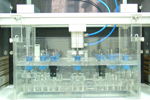
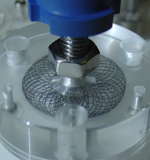
|
|
 |
 |
|
|
|
 |
Non-martensitic
needle-like structures on Ni-Ti alloys
|
 |
|
 |
Metallographic
preparation for microstructural studies on Ni-Ti alloys is by no means
trivial. The literature mentions several possible routines, but also
potential pitfalls: several phenomena like stress induced martensite or
ghost martensite can complicate concise interpretation of the
microstructure. In addition to these known phenomena, the occurrence of
needle-like structures is frequently observed on martensitic and
austenitic NiTi after metallographic preparation and etching. These
needle-like structures look very similar to martensitic structures.
Hence it is tempting to interpret them as martensite. Distinguishing
the structures from martensite is not straightforward, since EDX does
not yield any differences in chemical composition of the needle-like
structures and NiTi. Application of surface sensitive methods like
grazing incidence X-ray diffraction, glow discharge optical emission
spectrometry (GDOS), XPS and AES clearly show that the needle-like
structures are different from martensitic structures of NiTi and that
the material’s surface plays an important role to understand
the
formation of the structures.
|
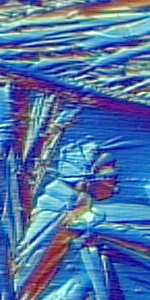
|
|
 |








